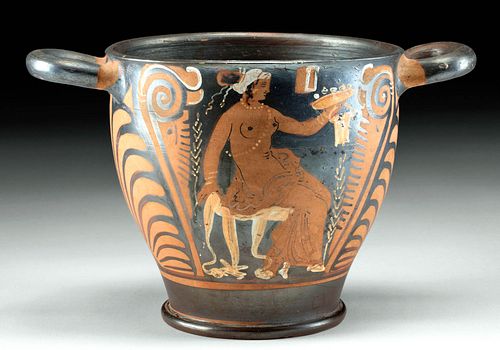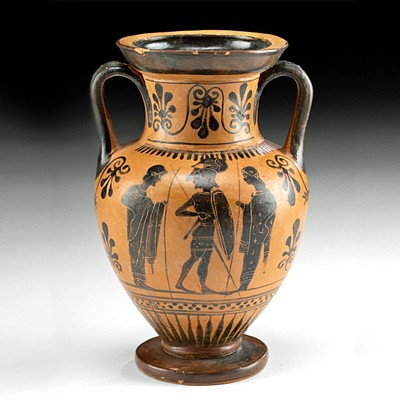Greek Apulian Red-Figure Skyphos w/ Lady & Ephebe, TL'd
Lot 37a
About Seller
Artemis Fine Arts
686 S Taylor Ave, Ste 106
Louisville, CO 80027
United States
Selling antiquities, ancient and ethnographic art online since 1993, Artemis Gallery specializes in Classical Antiquities (Egyptian, Greek, Roman, Near Eastern), Asian, Pre-Columbian, African / Tribal / Oceanographic art. Our extensive inventory includes pottery, stone, metal, wood, glass and textil...Read more
Categories
Estimate:
$3,600 - $5,400
Absentee vs Live bid
Two ways to bid:
- Leave a max absentee bid and the platform will bid on your behalf up to your maximum bid during the live auction.
- Bid live during the auction and your bids will be submitted real-time to the auctioneer.
Bid Increments
| Price | Bid Increment |
|---|---|
| $0 | $25 |
| $300 | $50 |
| $1,000 | $100 |
| $2,000 | $250 |
| $5,000 | $500 |
| $10,000 | $1,000 |
| $20,000 | $2,500 |
| $50,000 | $5,000 |
| $100,000 | $10,000 |
| $200,000 | $20,000 |
About Auction
By Artemis Fine Arts
Mar 9, 2023
Set Reminder
2023-03-09 10:00:00
2023-03-09 10:00:00
America/New_York
Bidsquare
Bidsquare : Exceptional Ancient, Ethnographic, & Fine Art
https://www.bidsquare.com/auctions/artemis-gallery/exceptional-ancient-ethnographic-fine-art-12354
Artemis Fine Arts info@artemisfinearts.com
Artemis Fine Arts info@artemisfinearts.com
- Lot Description
**First Time At Auction**
Magna Graecia, South Italic Colonies, Apulia, ca. 4th century BCE. An opulent terracotta skyphos hand-painted with red-figure decoration of a seated, semi-nude female and a standing ephebe draped in a long himation, all detailed in applied white and orange fugitive pigments. Leaning back atop a bench, the bare-chested female gazes right, her hair pulled up in a chignon as she extends forth her left arm holding before her a phiale with an offering and a situla. Alternatively, the male youth faces left, body and arms wrapped by his long himation as a an abstract design adorns the area before him and a quatrefoil decorates the area behind. Both figures are flanked by a pair of rising vines or stalks. Elegant palmettes sit below each horizontal loop handle, separating the 2 figures from one another. A fine example of the skyphos form, a drinking vessel upon a low foot with two short, horizontal handles, expertly built and painted. Size: 9" Diameter x 5.5" H (22.9 cm x 14 cm)
Perhaps the most exciting innovation in Greek vase painting was the red-figure technique, invented in Athens around 525 BCE and beloved by other artists of Magna Graecia. The red-figure technique allowed for much greater flexibility as opposed to the black-figure technique, for now the artist could use a soft, pliable brush rather than a rigid metal graver to delineate interior details, play with the thickness of the lines, as well as build up or dilute glazes to create chromatic effects. The painter would create figures by outlining them in the natural red of the vase, and then enrich these figural forms with black lines to suggest volume, at times perspectival depth, and movement, bringing those silhouettes and their environs to life. Beyond this, fugitive pigments made it possible for the artist to create additional layers of interest and detail as we see in this example.
This piece has been tested using thermoluminescence (TL) analysis and has been found to be ancient and of the period stated. A full printed and bound report will accompany the item upon purchase.
Provenance: private Beechwood, Ohio, USA collection, acquired via descent, before 2000
All items legal to buy/sell under U.S. Statute covering cultural patrimony Code 2600, CHAPTER 14, and are guaranteed to be as described or your money back.
A Certificate of Authenticity will accompany all winning bids.
We ship worldwide and handle all shipping in-house for your convenience.
#177647A few small chips commensurate with age, but otherwise intact and excellent with nice remaining pigments and detail. Beautiful, silvery iridescence to black glaze. TL holes on base and under handle.Condition
- Shipping Info
-
All shipping is handled in-house for your convenience. Your invoice from Artemis Gallery will include shipping calculation instructions. If in doubt, please inquire BEFORE bidding for estimated shipping costs for individual items.
-
- Buyer's Premium



 EUR
EUR CAD
CAD AUD
AUD GBP
GBP MXN
MXN HKD
HKD CNY
CNY MYR
MYR SEK
SEK SGD
SGD CHF
CHF THB
THB















